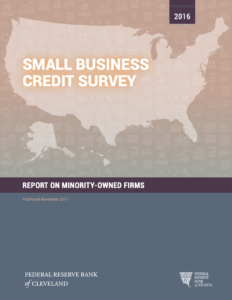 2016 Small Business Credit Survey: Report on Minority-Owned Firms
2016 Small Business Credit Survey: Report on Minority-Owned Firms
Federal Reserve Bank of Cleveland
First published November 2017
This report is the third in a series of reports based on the 2016 Small Business Credit Survey (SBCS), a national collaboration of the Community Development Offices of the 12 Federal Reserve Banks. As a key financial regulator and economic policymaker, the Federal Reserve System plays an important role in ensuring fair access to credit and promoting economic growth for the well-being of all Americans. Small businesses are an important component of economic success and strong communities; they are responsible for 48% of private sector employees nationwide, are important drivers of local and regional economic growth, and are an important source of household wealth. A healthy small business environment depends on an array of factors, not least of which is the ability to access funds for starting up, scaling up, or maintaining operations. However, as a growing number of studies document, access to funds—whether debt, equity, or personal resources— can vary across race and ethnicity even when business owners are similar in other respects such as business performance and credit risk.
The SBCS provides new data on minority-owned small business performance, financing needs, decisions, and outcomes. This report shares the descriptive comparison of the SBCS results by different firm ownership types (with emphasis placed on results that are statistically significant). A subsequent paper will investigate the independent marginal effects of race and ethnicity on credit experience. That paper will include an analysis that controls for firm age, size, and other available variables. The 2016 SBCS, which was fielded in Q3 and Q4 2016, yielded 7,916 responses from employer firms with race/ethnicity information in 50 states and the District of Columbia. We primarily report results by four race/ethnicity categories: white, black or African American, Hispanic, and Asian or Pacific Islander. However, when the respondent sample size by race for a particular survey question is too small, we report results in terms of minority- versus nonminority-owned firms [i.e., we compare the experience of minority-owned businesses to businesses with more than 50% ownership by white individual(s)]. For select key statistics, we also report results for the 4,365 nonemployer respondents who provided race/ethnicity information. The SBCS Report on Minority-Owned Firms, therefore, offers unique insight into important, often underserved, segments of the small business population.
Download Resource